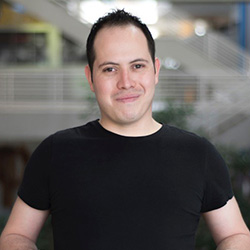News & Notices
Member Spotlight: Josafath Reynoso
 Q&A with scenic designer Josafath Reynoso
Q&A with scenic designer Josafath Reynoso
How were you introduced to scenic design?
When I was 11 or 12 it was during one of the worst economic crisis in the last 30 years. I almost had to drop out of school. I started at a vocational school where I learned basic carpentry and after that I got a scholarship to one of the biggest schools in Mexico. That is the first time I heard about theatre and got involved with the production crew building things.
I became Technical Director and by 2002 started designing for small companies. I hadn’t had any design experience. After that is when I started college for scenography.
Where do you draw inspiration from?
I do a lot of visual research but for me the set is always about the feelings in the play more than it is about the historical context. I’m always concerned less with the architecture and more about extracting the emotional content of the play. When I get it to its conversational expression, then I figure out how to translate that into visual terms. Most of my inspirations come from art pieces, artwork instillations, paintings, documentaries, movies, music, and cartoons – anything that relates even loosely to the emotions of the play. I do a lot of period research because I need to know those things, but it’s more about depicting the emotion in the play.
What challenges do you face as a designer?
The communication with directors can be complicated. Sometimes the director has a very clear idea of what they want in a set, sometimes it’s totally loose and you can do whatever you want. I’d rather work with a director that has an approximate idea of what he wants or at least and idea of again the emotional response that he’s expecting from the audience. That is something I can really work with. When it’s a director that really dictates “well I want two chairs and a table and a couple of doors” then it becomes more about solving his problems than about really finding your own voice through the set. And the opposite case when a director says “show me whatever” there’s no boundaries and therefore a lot of chance for disconnection. You and the director are talking about two totally different things.
How do you translate your visions into physical art?
I sketch a lot to inform myself, to tell what I’m really thinking about before I talk to the director. Most of the time I’ll show a piece of research like a cartoon or a piece of a movie or a couple of images. I want the director to get an emotional response and say “yes, this is what I think and feel about the play or this is what I think the audience should feel about the play” and from then on start deconstructing that image and finding what I think the director is drawn to.
After that it’s all about sketching. I work a lot in digital and I do a lot of digital models. I like building models but it’s about finding the right tools to communicate, the scale model or going straight to the drafting. It really depends on the complexity of the set.
How has USITT had an impact on your career and personal life?
As a foreigner, I battle with the fact that people don’t know me or my work, and I find myself with people who have been doing theatre since high school and have been networking since high school. I battle with this paradox of needing some design experience but nobody wants to give you a chance.
After grad school it was hard for me to build connections. Through conferences like USITT and competitions that’s how I’ve managed to get my name out, and get acquainted with people from different universities – Southeast Missouri State University where I was teaching for a year and now University of Richmond.
It’s been a process after graduation of course. The way I got to meet these people is through competing, getting my name out there, making connections with professionals and other students throughout the country.
Suggest a USITT Member for the Spotlight!
If you know of USITT members whose work should be in the Spotlight, please feel free to suggest them. Contact Lynne Dundas at lynne@usitt.org.

